Items
topic_interest is exactly
government
-
2020-07-01
The hidden costs of the pandemic
Covid-19 was a surprising event that has shaken how many view the world. I am here now retelling my story on behalf of HNSC 2100, Fall 2020, M. Horlyck-Romanovsky. The pandemic has brought the worst in many. People were selfish, people took advantage of those who were desperate, and there were countless fights for small things in stores when it wasn't a big necessity. It brought me to think that humanity is really that selfish. But in a turn of things, it also brought together many people. Those who cared for one another were always there to talk to, sharing what they could and giving helpful advice to handle this pandemic. This leads me to my family and friends. When it first began, I was scared and felt all alone. My friends were the first ones I'd contact and first hear from. Worry washed over me when I realized there were certain friends I rarely talked to, making me want to go through who I had contact with and those I didn't. Time felt short and precious as you see many people's lives ending too soon because of this virus. In a sense, it made me value life more. While this opened my eyes to one side of life, it also opened my views to another part of life. When there is a more significant issue, those in power still refuse to do what is for the greater good, but instead for profits. What could have been a perfect time to provide resources and funds to marginalized and those in poverty communities they desperately need to prepare for a foreseeable shutdown? Instead, nothing was done for a while, and jobs were taken away to keep everyone at home. There was money to use, especially in bigger businesses and the Government, but it needed to be seen as profitable. What was worse about this was that I actually worried that the Government wouldn't have money in general, but looking into how more prominent corporations asked for millions, if not billions, in compensation for lost revenue, which they did receive in the end, made me extremely upset at the priorities of where our society is. Not only first losing faith in humanity but also in our own governmental structures. I wanted to grow up to work at these more prominent corporations due to their fame and how they represent themselves. But seeing this and the lack of giving back for the greater good, I have lost interest in even being associated with these types of corporations. One big thing that did come from all this chaos was the need to advocate for the smaller groups of people who can't or are afraid to speak up. I now want to work in a place where we can easily provide feedback/assistance to communities that are being impacted but not cared for. I take inspiration from my friends who have been there by my side, taking time when they could and always showing their support. Without them, I couldn't have gone through the pandemic with my sanity intact. While on the topic of sanity, the ways that the cost of living and prices of food went up at such a dire time of need were the most insane part of this pandemic. No one can afford food; it is clear no one is willing to spend on higher quality foods, and it's going to waste, so in turn, the prices would go down, right? No. The entire industry would rather destroy their own crops than give them away at dirt-cheap prices when it would have benefited everyone. Getting rid of the excess waste while making some money for selling it cheaply and the people can actually eat healthily as the prices plummet due to an abundance of this resource. Being a good defense against the virus if your immune system is at its peak! It infuriates me that this did not occur. My family struggled to make ends meet and put food on the table. It was the first time I had to reach out to food pantries, and I saw such long lines. It was a saddening sight to see. Every day, week, month, you'd see a line. Just how many really needed help, but no one could provide it. And when help did arrive, it was a measly couple hundred dollars or close to a thousand after half a year of suffering. If only food prices would have gone down as the entire world was going down, too, that would have been a blessing in itself. Even today, it is hard not to find myself using a food pantry. I wish I wasn't and didn't require these services, but it has become a regular occurrence ever since the pandemic. Now that it has quieted down while still occurring around the states and the world, the virus has taught us one thing. We must be ready to fend for ourselves; it is a sad truth, but it has become an untrustable and helpful place for the Government. I hoped we could move toward a better future, but this wasn't true. But that is what I took from this, and I plan to do work to combat and help others. The one good thing I see that came from this is my experience. -
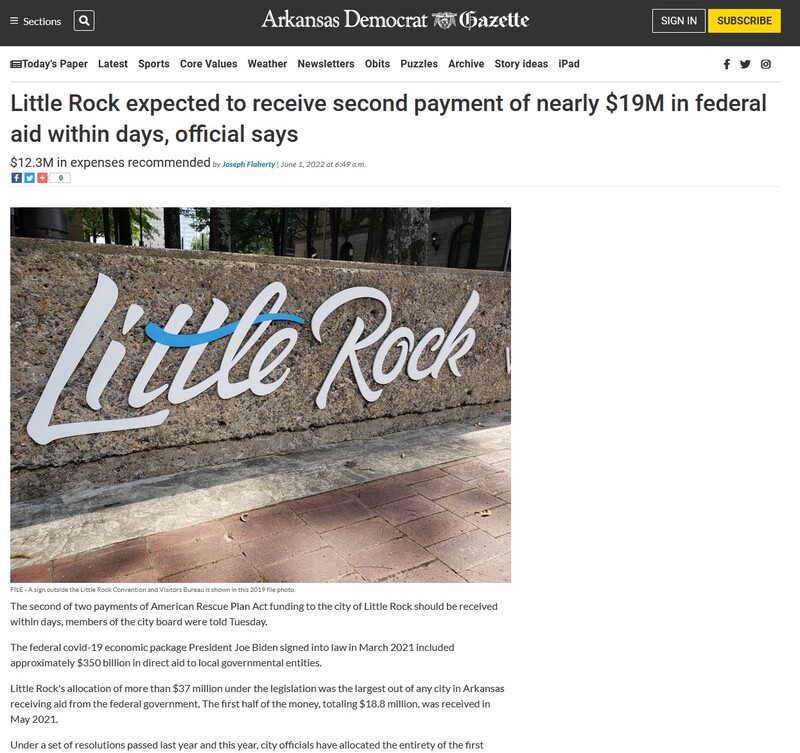 2022-06-01
2022-06-01Little Rock and Relief
This article details the $19 million dollars in aid Arkansas' capital received from the federal government. As part of the American Rescue Plan, many larger cities are receiving direct aid from the federal government and Little Rock previously received $18.8 million in May of 2021. The city has decided to allocate much of the funds to improving public works, renovations, and policing. It is interesting to see just how excessively covid impacted cities and the extreme necessity of federal aid. It is particularly beneficial when state legislatures have failed to provide money for needed refurbishment. However, payouts such as this begs the question: who will pay? -
 2022-05-02
2022-05-02You can't co-opt "my body, my choice"
This is a tweet from Anna Akana regarding the leaked opinion draft from the Supreme Court, which would overturn Roe v. Wade. Here, she is criticizing people who use "my body, my choice" in regards to masks, but don't allow it for when it comes to women's reproductive health. -
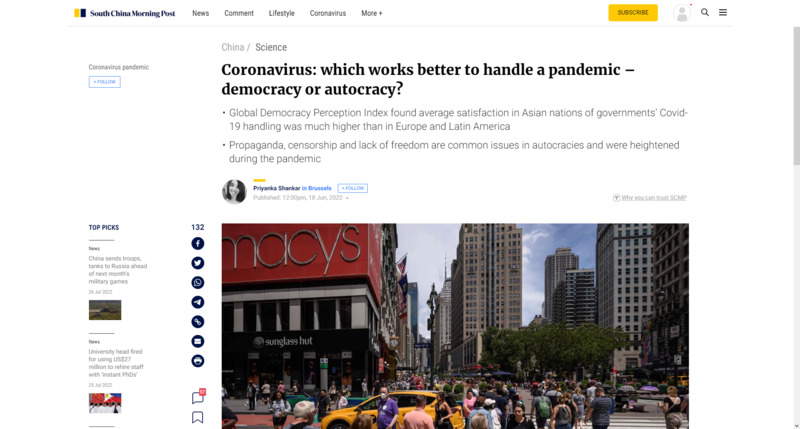 2022-06-18
2022-06-18Coronavirus: which works better to handle a pandemic – democracy or autocracy?
This is a news story from the South China Morning Post by Priyanka Shankar. This article is discussing the difference in responses based on forms of government. When it came to handling the pandemic, people from Asian countries where restrictions were much tougher rated a higher rate of satisfaction in government response compared to Latin America and Europe. This was taken from the Democracy Perception Index. According to researcher Fredrick DeVeaux, a leader in conducting this survey, the tight restrictions common in Asian countries are generally accepted because it gets associated with low death rates. The survey does make mention that in countries such as Iran and China, they hid data about the virus from their citizens, affecting their overall response to changes in lockdowns. However, Singapore is also authoritarian, and the prime minister has made an effort to create transparency in what is occurring, so items get hoarded less. Overall, the article claims that the mass mobilization of people and goods under authoritarian regimes fares better than democracies do at creating an effective COVID response. -
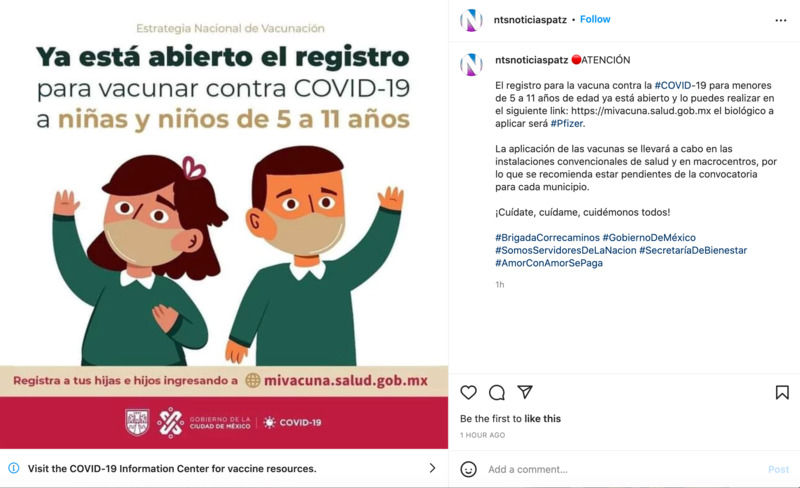 2022-06-17
2022-06-17Vaccines for kids 5-11
This is an Instagram post by ntsnoticiaspatz. It is saying that if you have not, you should register your kid to receive their vaccine. This is being promoted by the Mexican government. -
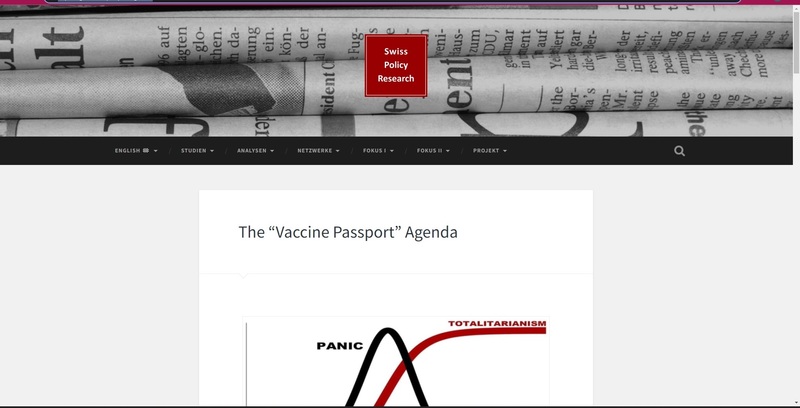 2021-12
2021-12The “Vaccine Passport” Agenda
This is information on vaccine passports by Swiss Policy Research. The overall message is that there is a correlation between totalitarianism and panic over the virus. This panic, in turn, has translated into governments around the world bringing up the possibility of vaccine passports. The vaccine passports may be used for more than vaccines, as they would be a way for the government to identify movement of individuals easier. The groups uses a number of ways to sway the audience, using information on what different organizations have funded, in addition to bringing up what other governments have said about the vaccine passports. Vaccine passports, according to this publication, really got traction from the digital identity lobby group ID2020 in February 2021, which has funding from both the Gates Foundation and the Rockefeller Foundation. The research foundation cites pushback against the vaccine passports too. Places like Ontario, Canada have had to take away the vaccine mandate for healthcare workers, as they would potentially lose many workers in the process. In Spain, they have been called "ineffective and unconstitutional." The publication ends by calling the pandemic a "plandemic," saying that it was likely lab-created for the purpose of controlling the populations more. I think given the information available, this is persuasive. There are links to where the claims come from, such as what Bill Gates says himself, as well as information on the Good Health Pass, which is a collaboration between many different organizations and their implementation of vaccine passports. In my own opinion, I find vaccine passports unconstitutional and an invasion of privacy. A vaccine passport makes it so you are forced to disclose personal health information to strangers in order to do things like grocery shopping, which I consider to be a potential HIPAA violation. It is also breech of the Fourth Amendment in the Constitution. If people feel inclined to get vaccinated, they should, but forcing people to do so through vaccine passports creates more overall distrust in the government. I have known people that would have otherwise have gotten the vaccine if it wasn't so forced. Even though vaccine passports were never mandated where I live, there have been people that have lost their livelihoods over not wanting to get vaccinated. I myself was very hesitant to get the vaccine for a while due to the way the government was handling it. Trying to implement vaccine passports and mandates has made it so society becomes more segregated, where unvaccinated would be forced to shop at different places, work at different places, and many other things. I am glad that the overall effort to actually do this has failed, but that is only because of many groups of people throughout the United States exercising their rights. I am pro-choice too, and I extend that reasoning to vaccine passports. People need bodily autonomy and vaccine mandates remove some of that. -
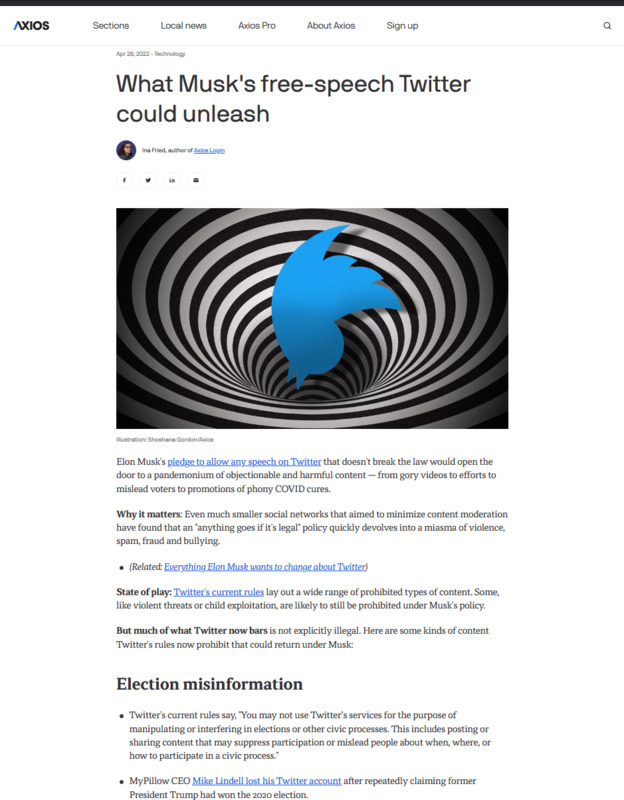 2022-04-28
2022-04-28What Musk's free-speech Twitter could unleash
This is a news story from Axios by Ina Fried. This is about the ramifications that could happen with Elon Musk's Twitter buyout. The author is worried about both election and COVID misinformation becoming more common on Twitter again. Other things added to this list include: sharing of manipulated media, impersonating others, increase of spam content, hateful conduct, and forms of violence being allowed. -
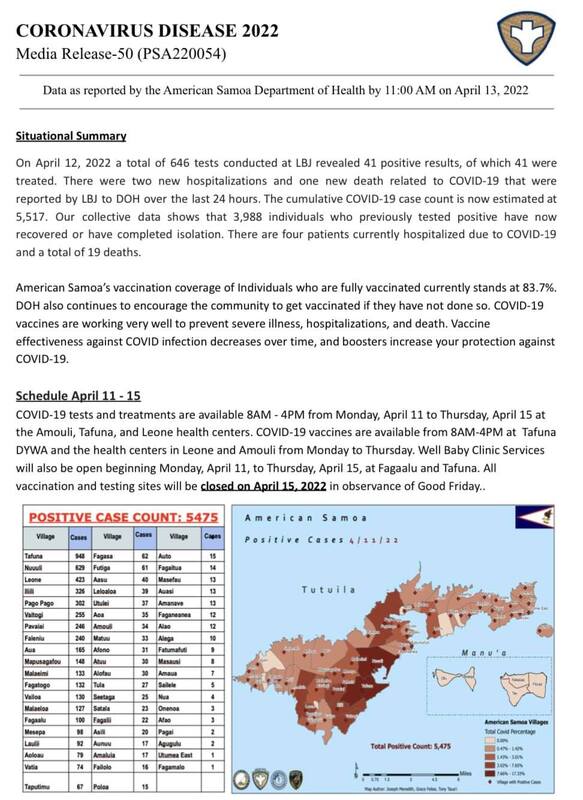 2022-04-13
2022-04-13American Samoa COVID Cases Situational Report #22
This is the twentieth-second report released by the American Samoa Department of Public Health regarding the rise of covid cases in American Samoa. As of April 13, 2022, positive cases have risen to 5457 from 5254 on April 08, 2022. A total of four individuals are hospitalized, and nineteen recorded deaths related to COVID-19 have been documented. American Samo's vaccination coverage of individuals who are fully vaccinated currently stands at 83.7%. -
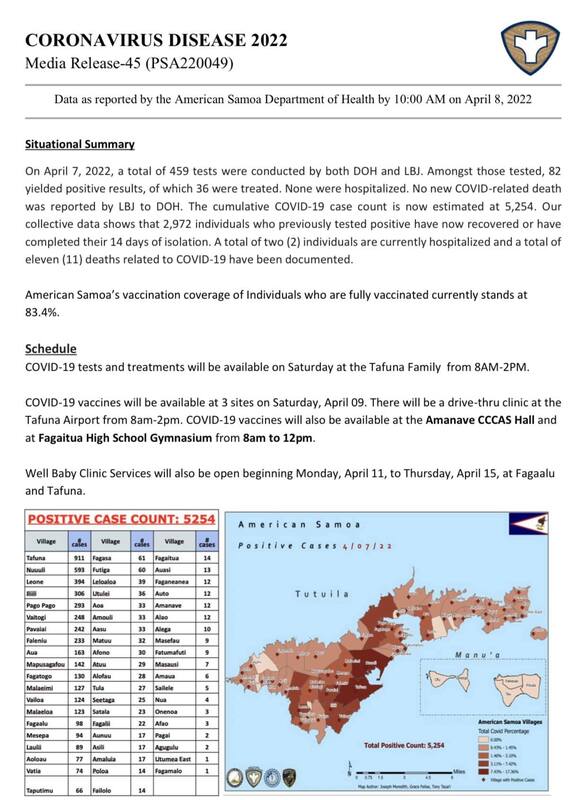 2022-04-08
2022-04-08American Samoa COVID Cases Situational Report #21
This is the twentieth-first report released by the American Samoa Department of Public Health regarding the rise of covid cases in American Samoa. As of April 08, 2022, positive cases have risen to 5254 from 4957 on April 05, 2022. A total of two individuals are hospitalized, and eleven recorded deaths related to COVID-19 have been documented. American Samo's vaccination coverage of individuals who are fully vaccinated currently stands at 83.4%. -
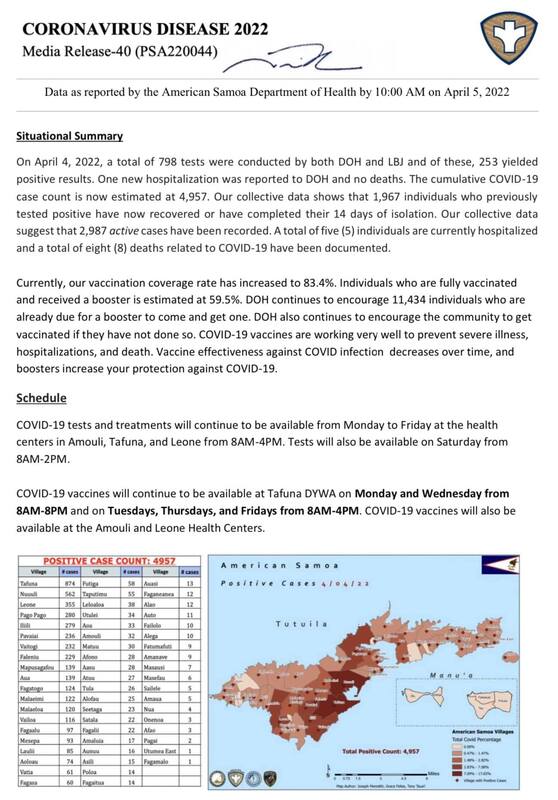 2022-04-05
2022-04-05American Samoa COVID Cases Situational Report #20
This is the twentieth report released by the American Samoa Department of Public Health regarding the rise of covid cases in American Samoa. As of April 05, 2022, positive cases have risen to 4957 from 3756 on March 29, 2022. A total of five individuals are hospitalized, and eight recorded deaths related to COVID-19 have been documented. -
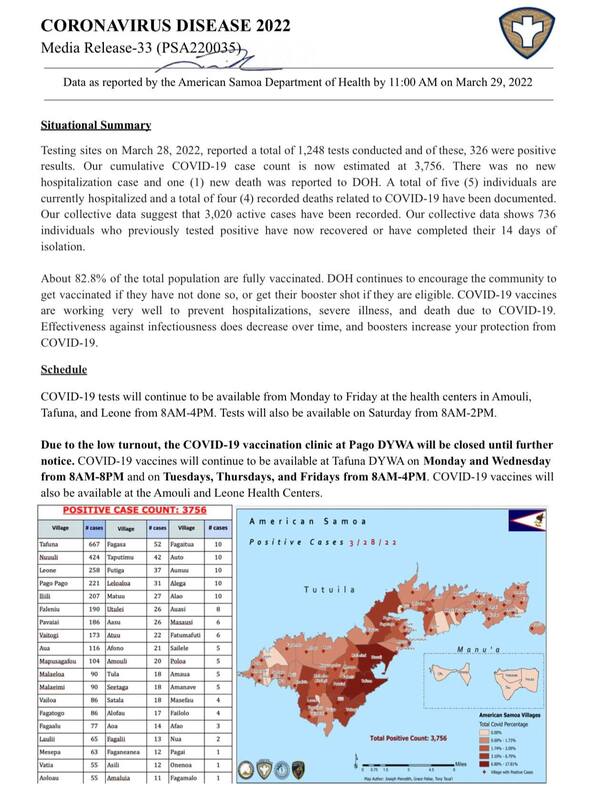 2022-03-29
2022-03-29American Samoa COVID Cases Situational Report #19
This is the nineteenth report released by the American Samoa Department of Public Health regarding the rise of covid cases in American Samoa. As of March 29, 2022, positive cases have risen to 3756 from 3381 on March 27, 2022. A total of five individuals are hospitalized and 4 recorded deaths related to COVID-19 have been documented. -
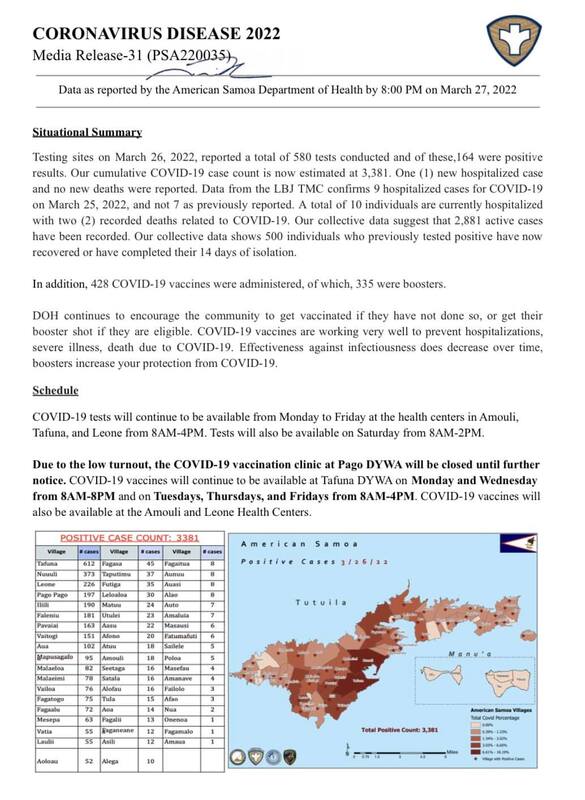 2022-03-27
2022-03-27American Samoa COVID Cases Situational Report #18
This is the eighteenth report released by the American Samoa Department of Public Health regarding the rise of covid cases in American Samoa. As of March 27, 2022, positive cases have risen to 3381 from 2953 on March 25, 2022. -
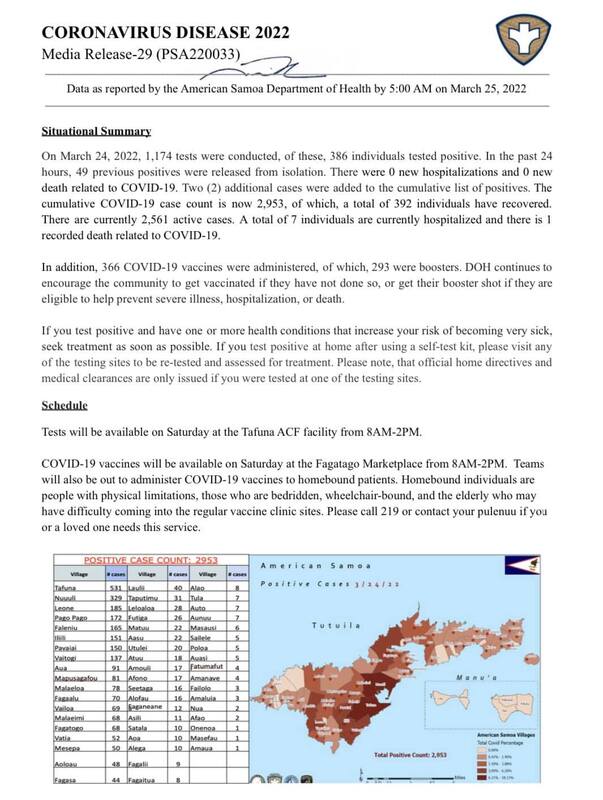 2022-03-25
2022-03-25American Samoa COVID Cases Situational Report #17
This is the seventeenth report released by the American Samoa Department of Public Health regarding the rise of covid cases in American Samoa. As of March 25, 2022, positive cases have risen to 2953 from 1932 on March 22, 2022. On this report, a number of 7 individuals are hospitalized to covid and there is 1 death related to COVID-19. -
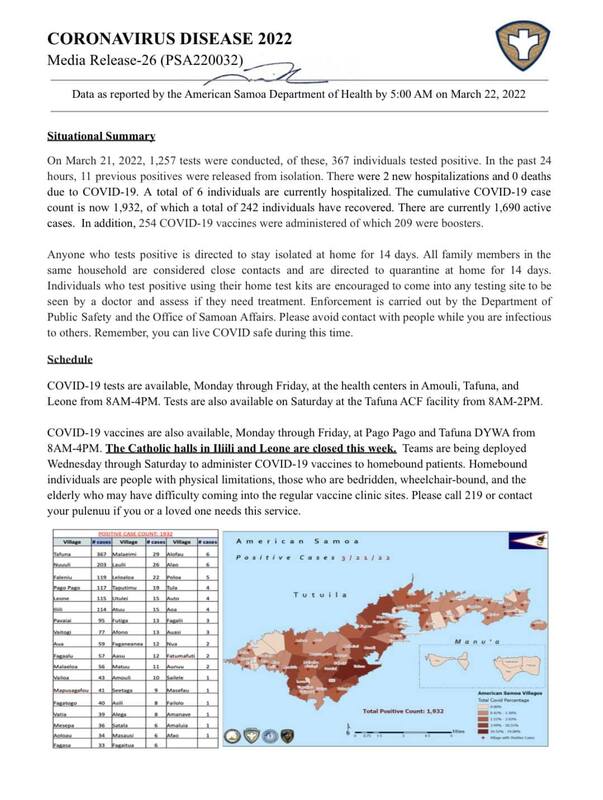 2022-03-22
2022-03-22American Samoa COVID Cases Situational Report #16
This is the sixteenth report released by the American Samoa Department of Public Health regarding the rise of covid cases in American Samoa. As of March 22, 2022, positive cases have risen to 1932 from 1565 on March 21, 2022. -
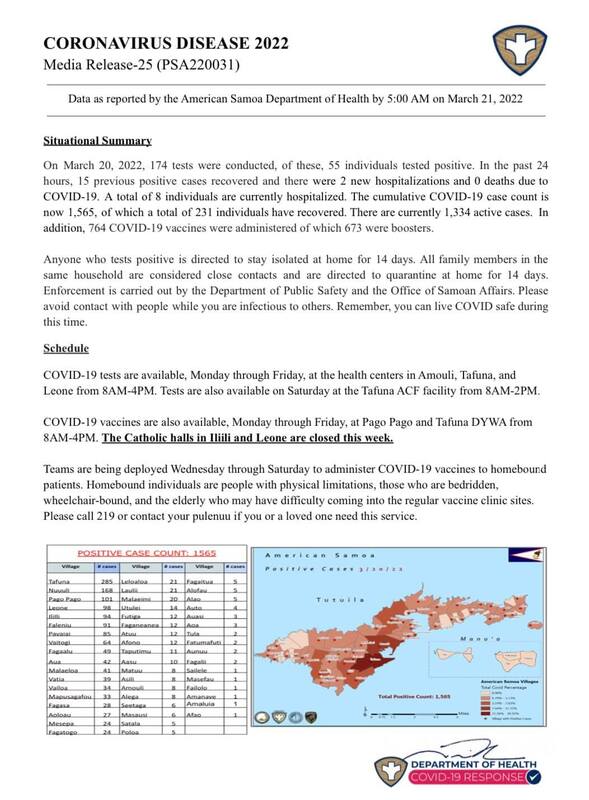 2022-03-21
2022-03-21American Samoa COVID Cases Situational Report #15
This is the fifteenth report released by the American Samoa Department of Public Health regarding the rise of covid cases in American Samoa. As of March 21, 2022, positive cases have risen to 1565 from 1188 on March 17, 2022. -
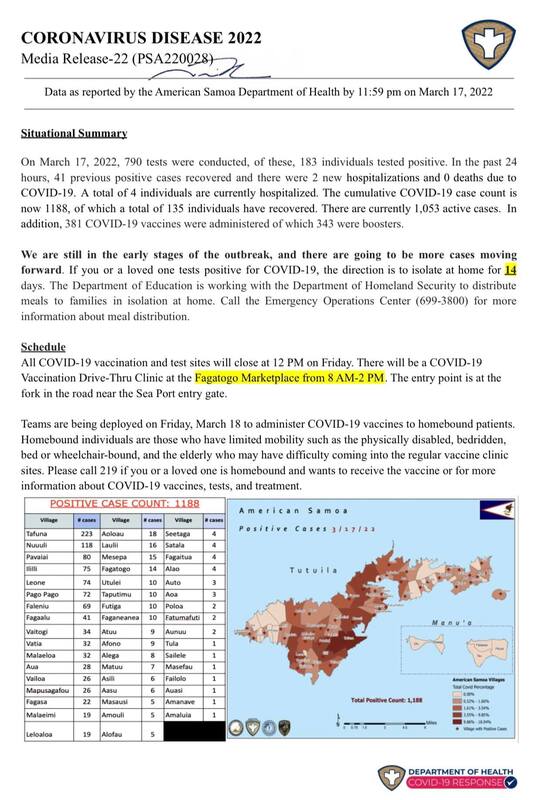 2022-03-17
2022-03-17American Samoa COVID Cases Situational Report #14
This is the fourteenth report released by the American Samoa Department of Public Health regarding the rise of covid cases in American Samoa. As of March 17, 2022, positive cases have risen to 1188 from 433 on March 10, 2022. -
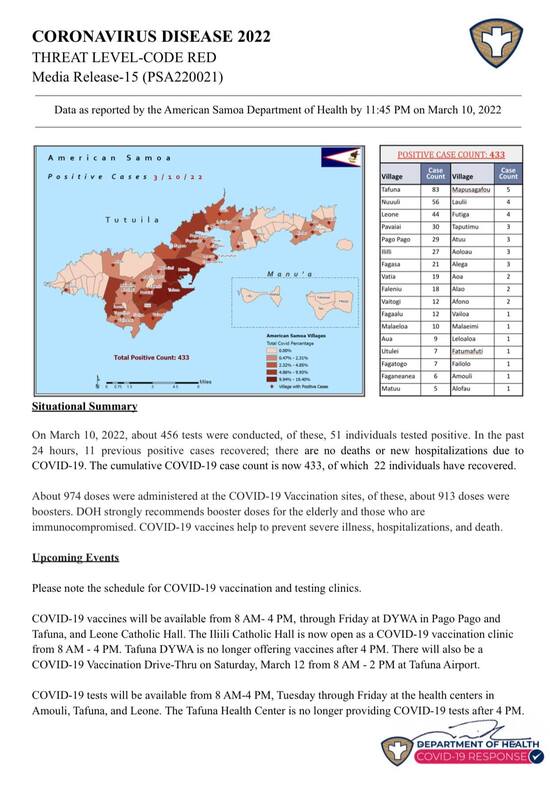 2022-03-10
2022-03-10American Samoa COVID Cases Situational Report #13
This is the thirteenth report released by the American Samoa Department of Public Health regarding the rise of covid cases in American Samoa. As of March 10, 2022, positive cases have risen to 433 from 343 on March 9, 2022. The DOH advised that elders are strongly recommended to get the booster shot. -
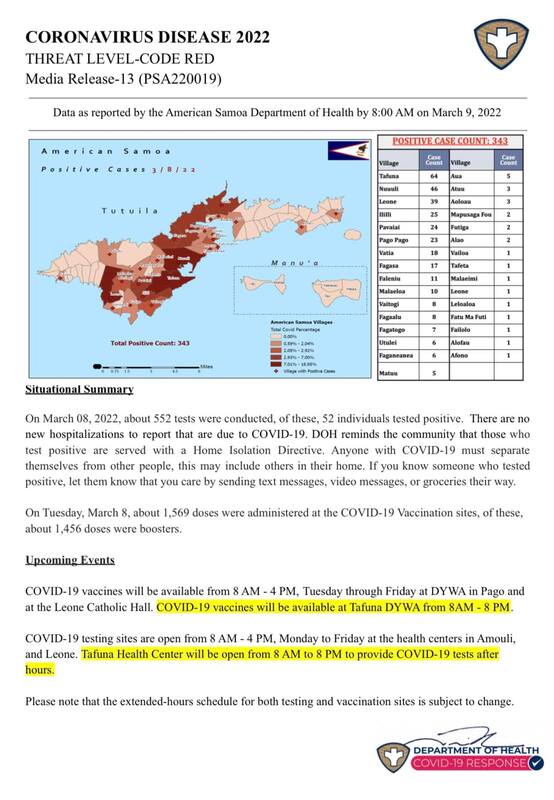 2022-03-09
2022-03-09American Samoa COVID Cases Situational Report #12
This is the twelfth report released by the American Samoa Department of Public Health regarding the rise of covid cases in American Samoa. As of March 9, 2022, positive cases have risen to 343 from 291 on March 7, 2022. The people of American Samoa are still advised to get their vaccine shots and booster shot. The numbers jumped by 52 cases after two days. The report also shows how many doses of vaccine and booster were administered. -
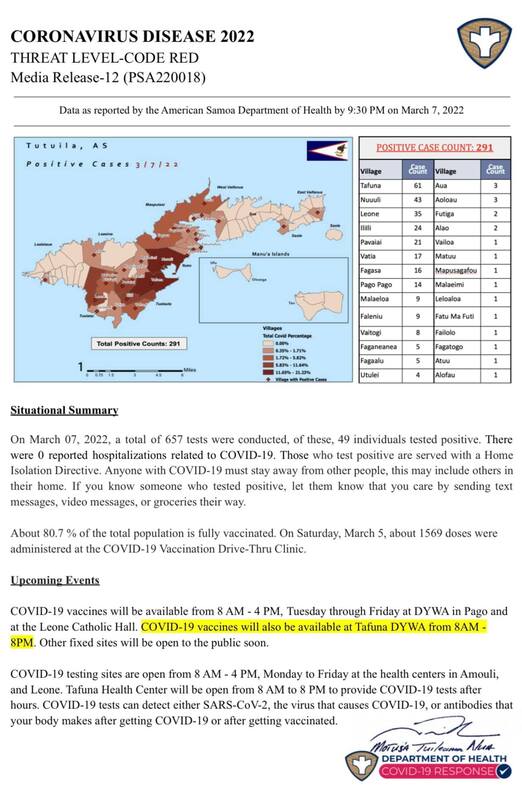 2022-03-07
2022-03-07American Samoa COVID Cases Situational Report #11
This is the eleventh report released by the American Samoa Department of Public Health regarding the rise of covid cases in American Samoa. As of March 7, 2022, positive cases have risen to 291 from 243 on March 6, 2022. The people of American Samoa are still advised to get their vaccine shots and booster shot. It is also heartwarming that within these reports that are released to the public, the DOH encourages people to send text messages, video messages, or groceries to someone who tested positive. -
 2022-03-06
2022-03-06American Samoa COVID Cases Situational Report #10
This is the tenth report released by the American Samoa Department of Public Health regarding the rise of covid cases in American Samoa. As of March 6, 2022, positive cases have risen to 243 from 229 on March 5, 2022. The people of American Samoa are still advised to get their vaccine shots and booster shot. And if they are to get tested, there are clinics on the East and West of the island to get tested if people are positive. The DOH released these reports daily or weekly to inform the public about the number of cases on the island. -
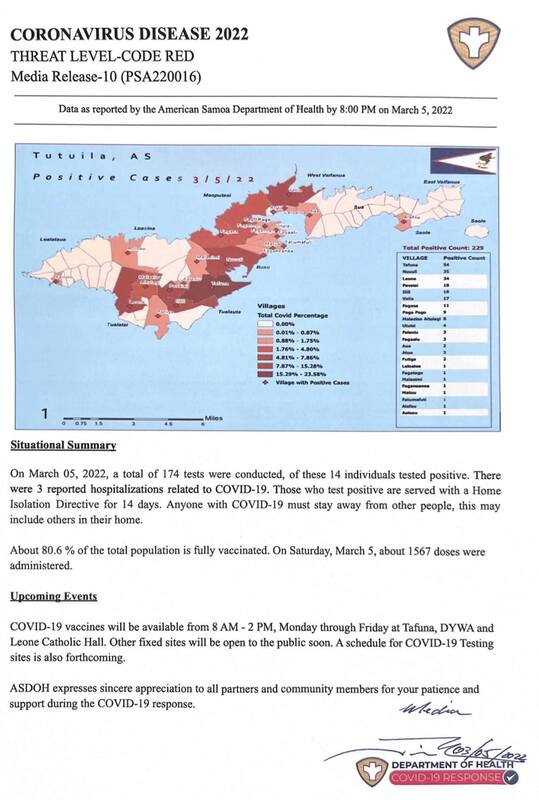 2022-03-05
2022-03-05American Samoa COVID Cases Situational Report #9
This is the ninth report released by the American Samoa Department of Public Health in regards to the rise of covid cases in American Samoa. As of March 5, 2022, positive cases have risen to 229 from 215 on March 4, 2022. -
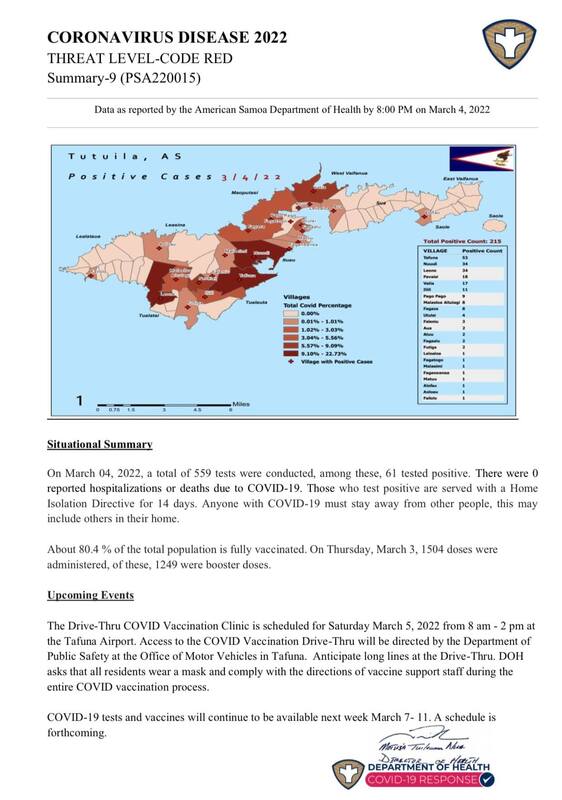 2022-03-04
2022-03-04American Samoa COVID Cases Situational Report #8
This is the eighth report released by the American Samoa Department of Public Health in regards to the rise of covid cases in American Samoa. As of March 4, 2022, positive cases have risen to 215 from 154 on March 3, 2022. The DOH also changed the look of the Situational Report to show the map of American Samoa and color-coded villages with their number of cases. -
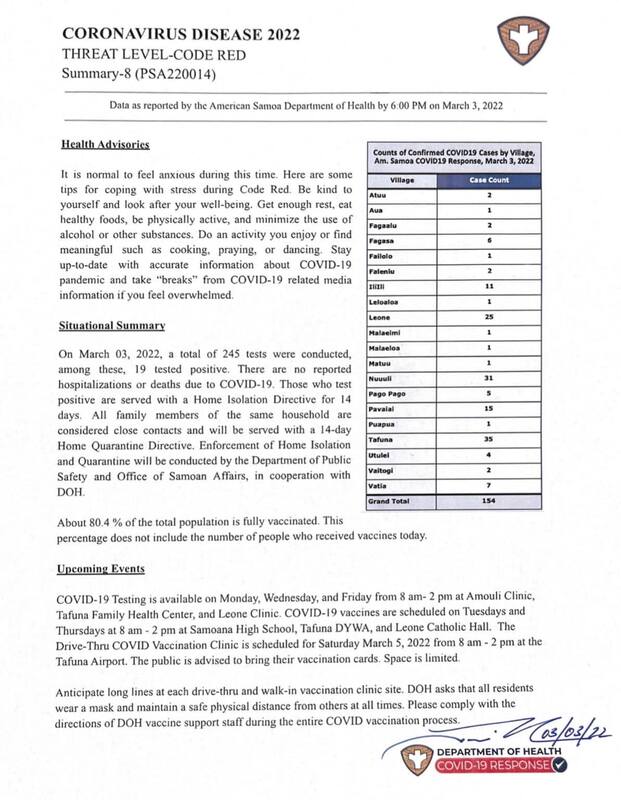 2022-03-03
2022-03-03American Samoa COVID Cases Situational Report #7
This is the seventh report released by the American Samoa Department of Public Health in regards to the rise of covid cases in American Samoa. As of March 3, 2022, positive cases have risen to 154 from 135 on March 2, 2022. -
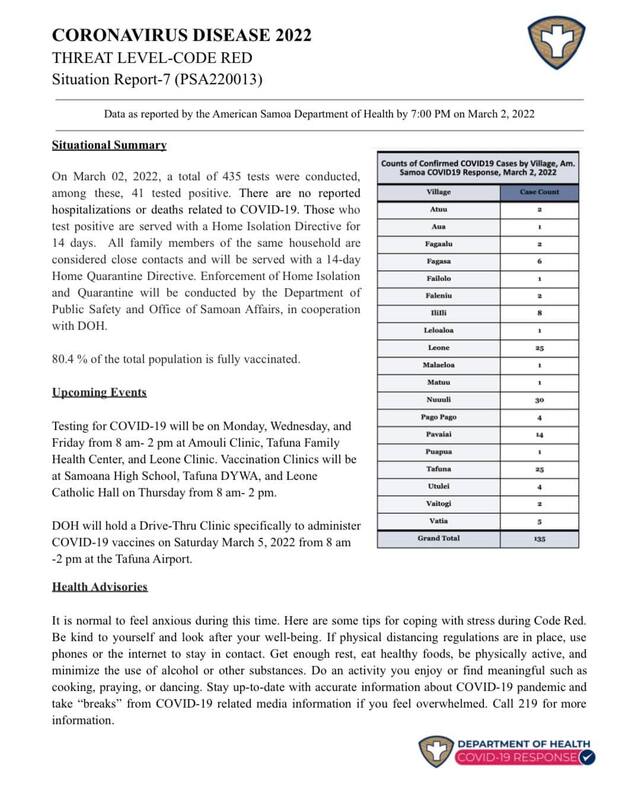 2022-03-02
2022-03-02American Samoa COVID Cases Situational Report #6
This is the sixth report released by the American Samoa Department of Public Health in regards to the rise of covid cases in American Samoa. As of March 2, 2022, positive cases have risen to 135 from 94 on March 1, 2022. -
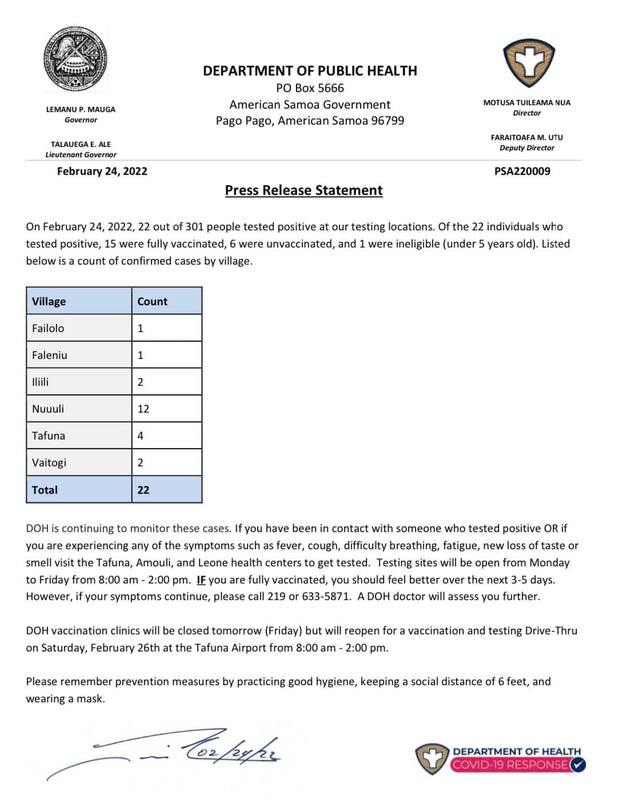 2022-02-24
2022-02-24American Samoa COVID Cases Situational Report #1
This is a report from the American Samoa Department of Public Health in regards to reporting the number of cases American Samoa has with COVID reaching the island. Ever since cases began to rise on the island, the American Samoa Department of Public Health has been releasing these situational reports on COVID cases publicly and weekly. The importance of these reports was to keep the public inform and we could see just how fast the disease spread in a significantly high amount weekly or even in a couple of days. -
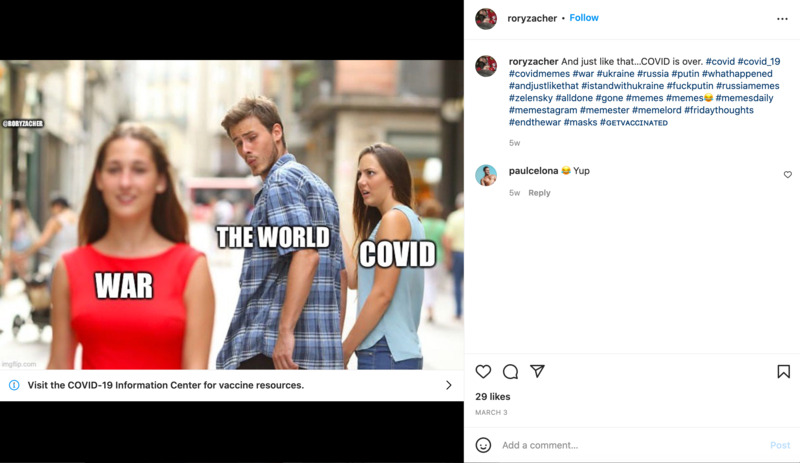 2022-03-03
2022-03-03And just like that...COVID is over
This is an Instagram post by roryzacher. This is a meme showing what they think about the virus. This is a popular meme of a guy looking back at a girl in red, with his angry girlfriend in blue to the side of him. This meme became popular in the mid-2010s and has retained its popularity. In this context, it means now that there is a war, the COVID narrative is gone. This is commonly used by pandemic skeptics since they believe many of the COVID restrictions were more political rather than for health reasons. The war this is referencing is the Russian invasion on Ukraine. -
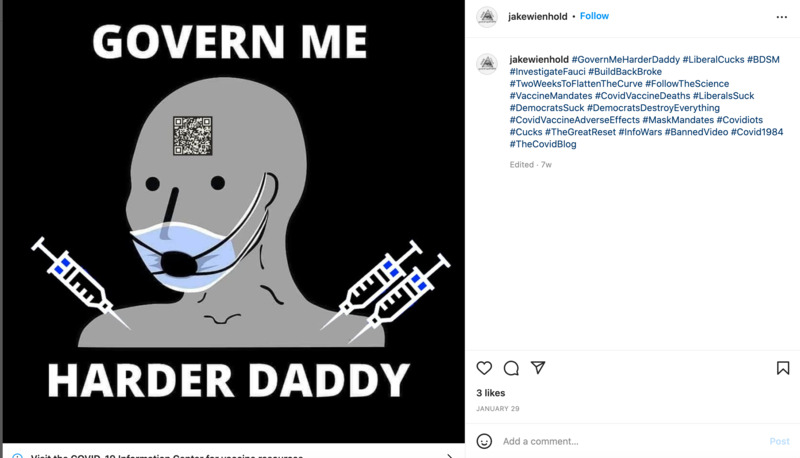 2022-01-29
2022-01-29Govern Me Harder Daddy
This is an Instagram post by jakewienhold. The picture posted by this user shows an NPC accepting all the COVID restrictions. The NPC is the grey character. The NPC itself is a meme that got popular in the late 2010s and has continued to have popularity into the 2020s. NPC stands for "Non Playable Character." The term has its origins in gaming where characters that have a pre-written script and can't go beyond that are an "NPC." This term has gone beyond gaming and has been used to refer to people of any political stripe as an NPC as an insult. It insinuates that people who would follow herd mentality for any cause have no thoughts of their own, like an NPC in a video game. The context of this picture shows an NPC having multiple vaccines injected in, while wearing a mask and a ball gag. The vaccines are referring to the COVID vaccines that some places have asked for people to go beyond two and get boosters. To critics of this, they see this as a ploy by big government and pharmacy to gain more money at the expense of the health of the people, as it is a common belief among the critics to claim that the vaccines are not safe. The mask has been a common trend during the pandemic, and is commonly used by critics to show that people following the rules imposed are being submissive towards the government. The ball gag is an extra thing that was added to show submissiveness and has some sexual connotations. The barcode on the forehead is a mark of being branded by the government and being tracked by said government. As with the things explained of this image, majority of the criticisms of the pandemic are based on the government response to it. For how much it limited some people's ability to make money or get things done that they needed to do, a lot of that anger is toward those governments limiting those freedoms. -
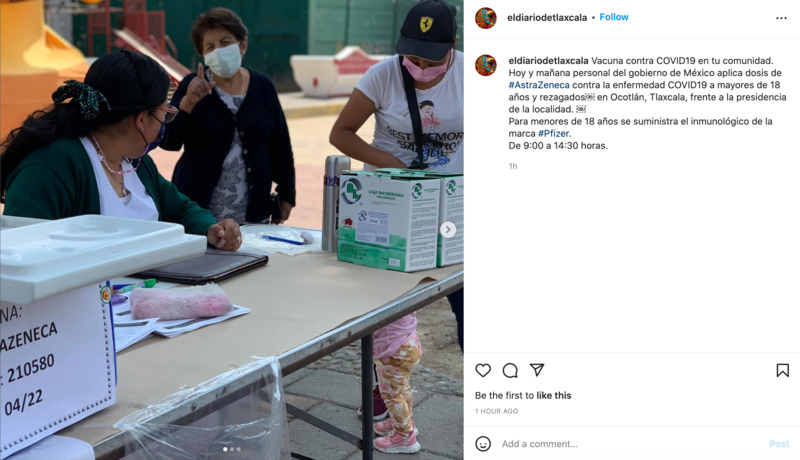 2022-04-12
2022-04-12Vacuna contra COVID19
This is an Instagram post by eldiariodetlaxcala. This is written in Spanish and is about information for people to get the AstraZeneca vaccine. This event will be held for two days. In the picture, we see volunteers working to help administer the vaccine. Only people 18 and above are eligible for this vaccine, and it is being held in Ocotlán, Tlaxcala. -
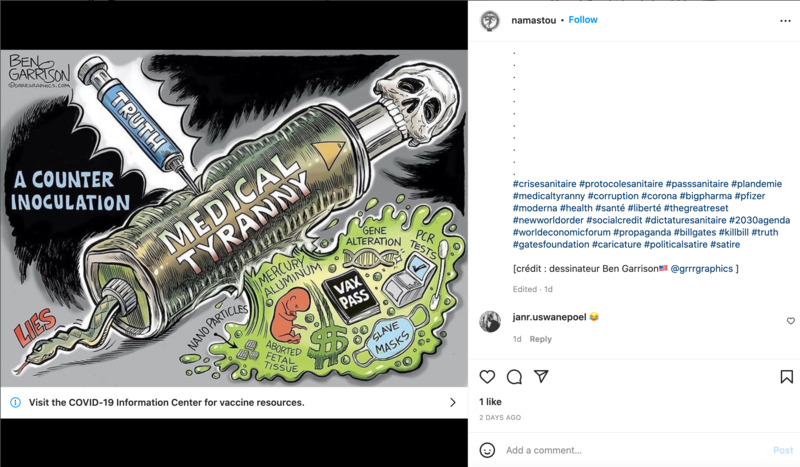 2022-04-05
2022-04-05Truth Serum
This is an Instagram post by namastou, and is partly in French. The comic posted in addition to the caption is by Ben Garrison, a political comic artist based in the United States. The comic shows how "truth" is being injected into "medical tyranny", and with that, the truth is that the masks are akin to making you slaves to the government, the vaccines cause gene alteration, and that PCR tests can come out as a false positive. -
 2022-04-07
2022-04-07Brainwashing
This is an Instagram post by we_stand_together_uk. The post shows a comic of a man and his brain full of different narratives, with the man looking fearful. Quite a few of the narratives depicted are COVID related, such as: "masks work", "trust the science", and "get boosted now." The poster themselves in the tags says #saynotothevaccine and #wewillnotcomply, making me believe that they think that everyone that has taken the vaccine has been brainwashed in some way to accept it, when they believe it is dangerous. -
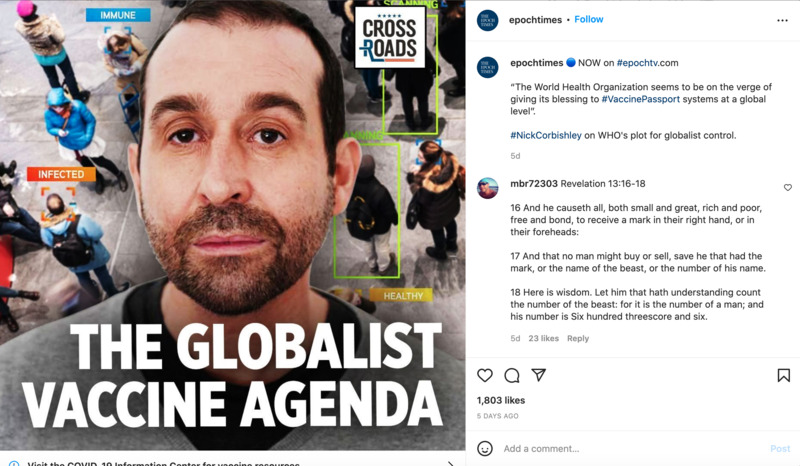 2022-04-02
2022-04-02The Globalist Vaccine Agenda
This is an Instagram post by epochtimes. The Epoch Times is a news organization. According to this post, it says that the vaccine passports are ways to limit freedom from government leaders. From my own experience with these arguments, a lot of it is not based on the vaccines themselves, but the fear of less rights to movement and more government spying. The vaccine passports would just be a way for the government to exert more control over the populace, using vaccines and public health as a facade to that. When I was searching for items to add, I used the #vaccine to find this. Noticeably, I had to click past a few things to even look under this hashtag, and it didn't allow me to see past a few posts, as Instagram has blocked from view many of the search results that come from this hashtag in particular. This was one of the few posts Instagram allowed me to see. -
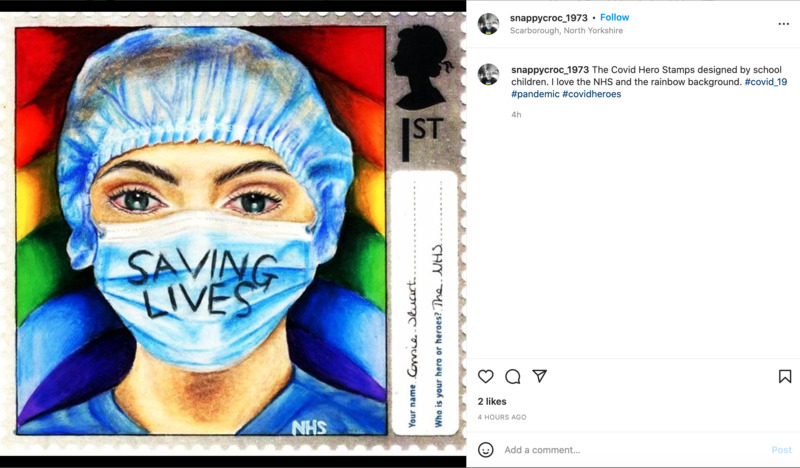 2022-04-07
2022-04-07COVID Heroes
This is an Instagram post by snappycroc_1973. This user posted a picture of one of the COVID Hero Stamps designed by school children. These stamps are meant to support the NHS (National Health Service), which is based in the United Kingdom. -
 2022-04-07
2022-04-07Where the Government Requires Masks
This is an Instagram post by urbanpeaceinstitute. This post refers to places where mask mandates are still in existence. Even though mask mandates have been lifting in many places, certain places still want masks. Some of these places include: emergency and homeless shelters; public transit; healthcare settings; long-term care facilities; and correctional and detention facilities. These places are either government or healthcare associated. This post links to the County of Los Angeles Public Health for more information on the Coronavirus. -
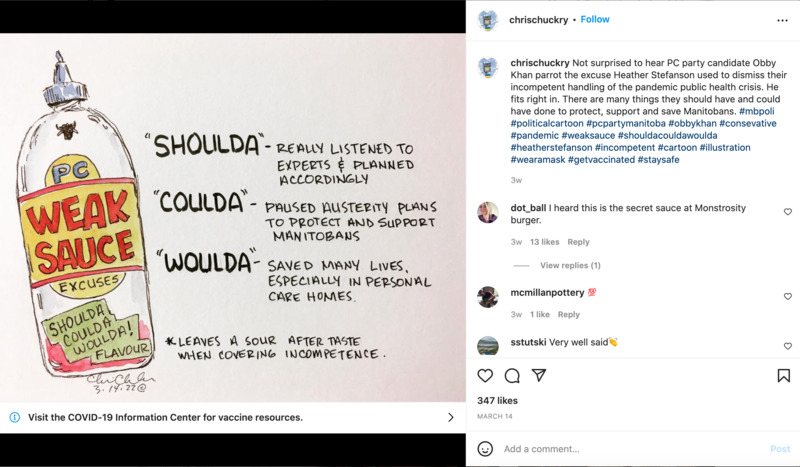 2022-03-14
2022-03-14Weak Sauce
This is an Instagram post by chrischuckry and it is a political comic on the incompetence on part of the Canadian government and the handling of the pandemic. Obby Khan, who is referenced in this post, is a Pakistani-Canadian politician. This user is accusing him of using the same excuses as Heather Stefanson, who is the premier of Manitoba, a Canadian province. The political comic is upset about politicians in Manitoba "not listening to experts" and allowing the pandemic to become more dangerous. -
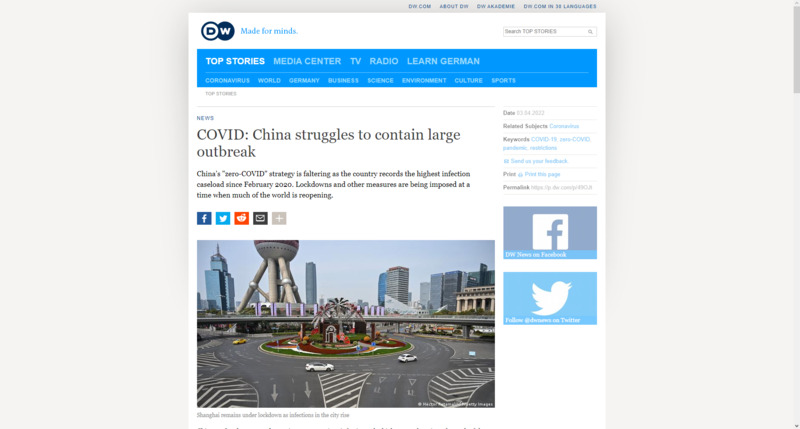 2022-04-03
2022-04-03COVID: China struggles to contain large outbreak
This is a news story by DW News. It is a story about how the outbreak of COVID has not been very well controlled in China, with China reporting 13,146 new cases, the most since the beginning of the pandemic in 2020. Despite these numbers, the Chinese government has claimed that there have been no new deaths despite the high number of infections. Shanghai is the worst affected region in China, in which as city of 25 million has been under lockdown. Vice President Sun Chunlan, who is on the Communist Party's Politburo claims that swift actions taken will help stop the spread of the virus. In Beijing, there have been lockdowns, mass testing, and travel restrictions placed on the populace. Residents of Shanghai are worried about the lockdowns exceeding four days, as it will limit their ability to obtain fresh food. Parents also fear being separated from their children for too long under strict quarantine. The article mentions Xi being in tough spot with this too, as these lockdowns will have an ill effect on an already fragile economic situation. -
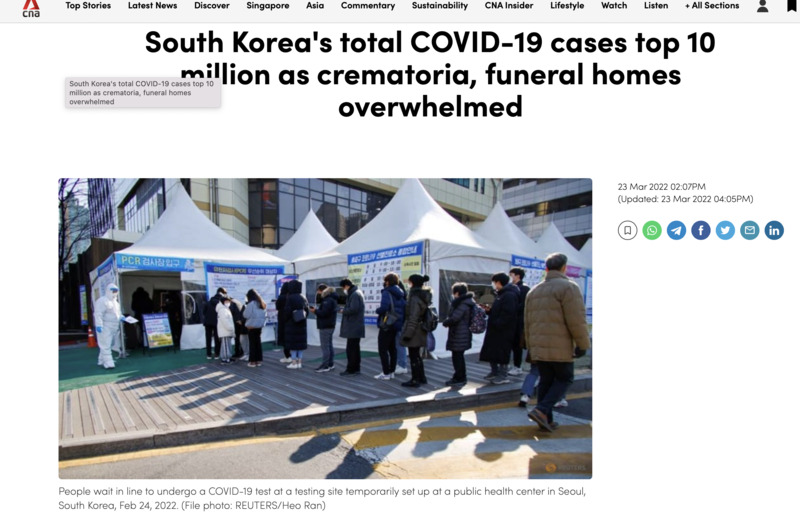 2022-03-23
2022-03-23South Korea's total COVID-19 cases top 10 million as crematoria, funeral homes overwhelmed
This is a story by Channel News Asia about the ongoing issues with funeral homes in South Korea. This article says that in Seoul, 28 crematoria are operating at 114.2% capacity, while other crematoria around the country are operating at 83%. For the past two week, the number of critically ill patients has been hovering above 1,000; but it could get to 2,000 by early April. To combat this, the federal government has approved the use of Merck & Co's COVID-19 treatment pill. The pill is branded as Lageviro and is the second antiviral to be authorized in South Korea after Pfizer's Paxlovid. This pill, however, is only approved for adults 18 and above. The government is hoping that actions such as these will help limit the crowdedness in funeral homes and hospitals. -
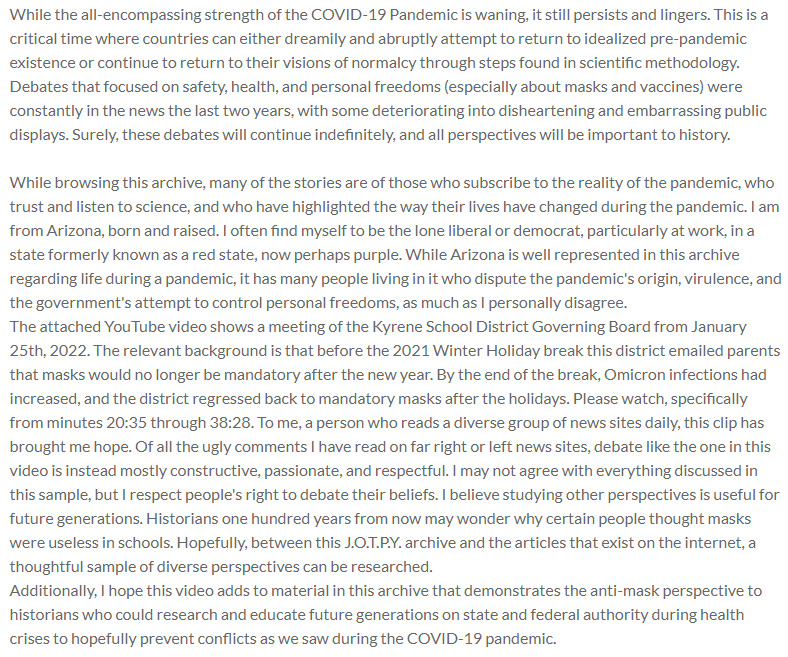 2022-03-15
2022-03-15Passionate and (mostly) respectful recent debate in the waning pandemic
While the all-encompassing strength of the COVID-19 Pandemic is waning, it still persists and lingers. This is a critical time where countries can either dreamily and abruptly attempt to return to idealized pre-pandemic existence or continue to return to their visions of normalcy through steps found in scientific methodology. Debates that focused on safety, health, and personal freedoms (especially about masks and vaccines) were constantly in the news the last two years, with some deteriorating into disheartening and embarrassing public displays. Surely, these debates will continue indefinitely, and all perspectives will be important to history. While browsing this archive, many of the stories are of those who subscribe to the reality of the pandemic, who trust and listen to science, and who have highlighted the way their lives have changed during the pandemic. I am from Arizona, born and raised. I often find myself to be the lone liberal or democrat, particularly at work, in a state formerly known as a red state, now perhaps purple. While Arizona is well represented in this archive regarding life during a pandemic, it has many people living in it who dispute the pandemic's origin, virulence, and the government's attempt to control personal freedoms, as much as I personally disagree. The attached YouTube video shows a meeting of the Kyrene School District Governing Board from January 25th, 2022. The relevant background is that before the 2021 Winter Holiday break this district emailed parents that masks would no longer be mandatory after the new year. By the end of the break, Omicron infections had increased, and the district regressed back to mandatory masks after the holidays. Please watch, specifically from minutes 20:35 through 38:28. To me, a person who reads a diverse group of news sites daily, this clip has brought me hope. Of all the ugly comments I have read on far right or left news sites, debate like the one in this video is instead mostly constructive, passionate, and respectful. I may not agree with everything discussed in this sample, but I respect people's right to debate their beliefs. I believe studying other perspectives is useful for future generations. Historians one hundred years from now may wonder why certain people thought masks were useless in schools. Hopefully, between this J.O.T.P.Y. archive and the articles that exist on the internet, a thoughtful sample of diverse perspectives can be researched. Additionally, I hope this video adds to material in this archive that demonstrates the anti-mask perspective to historians who could research and educate future generations on state and federal authority during health crises to hopefully prevent conflicts as we saw during the COVID-19 pandemic. This video is owned and uploaded by the Kyrene School District to YouTube. -
2020-03-30
Having to wear masks
The news article I put is an article about having to wear masks through the pandemic. This was a big change for America with many people wearing masks to help slow the spread and keep ourselves and those around us safe from covid. Many states had laws on when to wear masks, this was a historic moment for America when they announced we had to wear masks because the covid illness is very serious. -
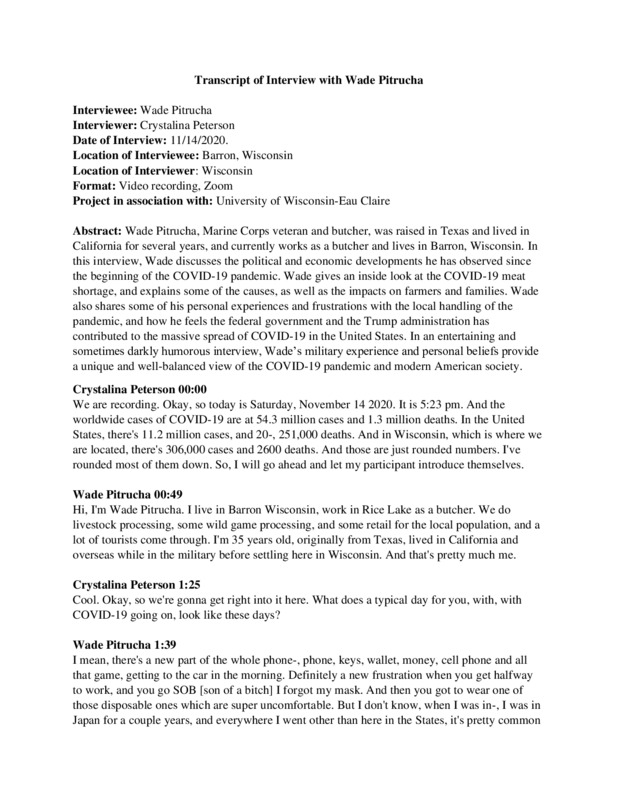 12/01/2020
12/01/2020Wade Pitrucha Oral History, 2020/12/01
Wade Pitrucha, Marine Corps veteran and butcher, was raised in Texas and lived in California for several years, and currently works as a butcher and lives in Barron, Wisconsin. In this interview, Wade discusses the political and economic developments he has observed since the beginning of the COVID-19 pandemic. Wade gives an inside look at the COVID-19 meat shortage, and explains some of the causes, as well as the impacts on farmers and families. Wade also shares some of his personal experiences and frustrations with the local handling of the pandemic, and how he feels the federal government and the Trump administration has contributed to the massive spread of COVID-19 in the United States. In an entertaining and sometimes darkly humorous interview, Wade’s military experience and personal beliefs provide a unique and well-balanced view of the COVID-19 pandemic and modern American society. -
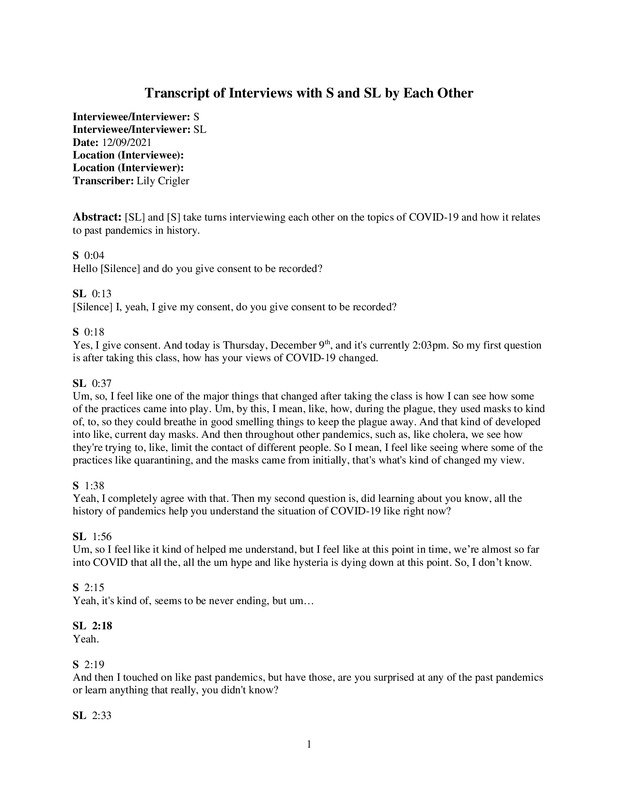 12/09/2021
12/09/2021SL and S Oral History, 2021/12/09
[SL] and [S] (Last name unknown) take turns interviewing each other on the topics of covid-19 and how it relates to past pandemics in history. -
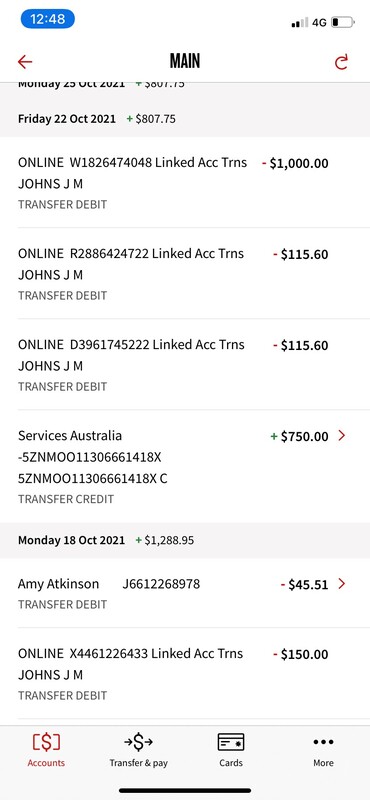 2021-10-01
2021-10-01(HIST30060) Disaster Payment: "Getting Payed to Study"
HIST30060. The COVID-19 Disaster Payment, given to workers unable to earn income due to COVID-19 state or territory health order, was given to construction workers during the two-week construction shutdown in Victoria. Traffic control in the construction sector has been my casual job alongside university for the past three years. The recent construction shutdown, however, allowed me to receive the $750 a week from the Disaster Payment without working at all. My housemates and I called this “getting paid to study”. This was especially true in the lead up to exams were we spent the majority of time at home with very little excuse to do anything other than “hit the books”. -
2021-10-01
Disaster Payment: "Getting Paid to Study"
The COVID-19 Disaster Payment, given to workers unable to earn income due to COVID-19 state or territory health order, was given to construction workers during the two-week construction shutdown in Victoria. Traffic control in the construction sector has been my casual job alongside university for the past three years. The recent construction shutdown, however, allowed me to receive the $750 a week from the Disaster Payment without working at all. My housemates and I called this “getting paid to study”. This was especially true in the lead up to exams were we spent the majority of time at home with very little excuse to do anything other than “hit the books”. -
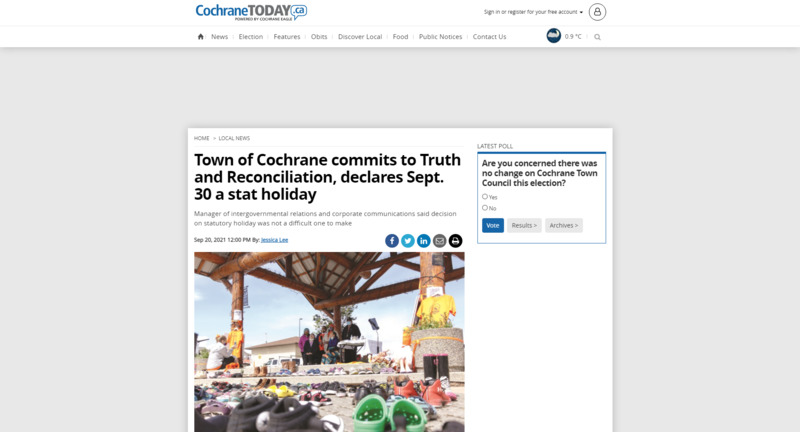 2021-09-20
2021-09-20Town of Cochrane commits to Truth and Reconciliation, declares Sept. 30 a stat holiday
This is a newspaper from Cochrane Today, a subsidiary of the Cochrane Eagle on the adoption of the National day of Truth and Reconciliation in the town of Cochrane. The document talks about how other municipalities and even the provincial government have chosen not to participate in the first day of this incredibly important national holiday. -
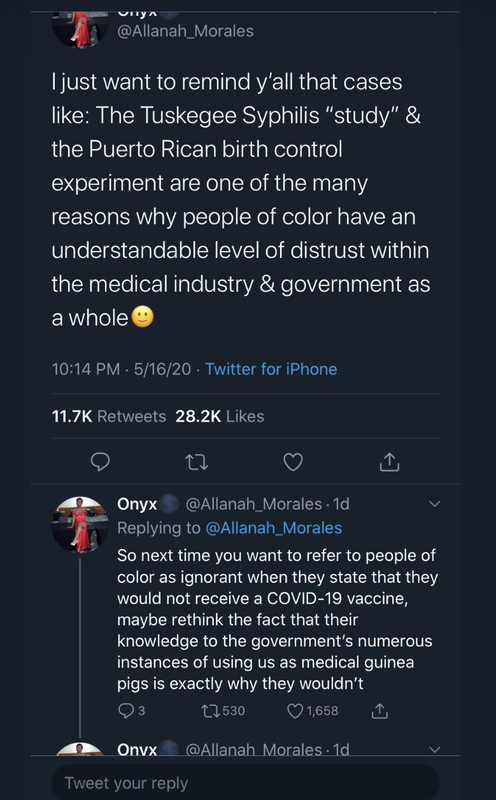 2021-05-16
2021-05-16Vaccine Hesitancy in the Black Community
This tweet reflects an ongoing controversy of the Covid-19 vaccine. The media has reported a hesitancy of the mRNA vaccine amongst the black community, but with little to no context on why there is such hesitancy. Based on the history of the U.S. public health institution, there have been reported inequalities that include a racial hierarchy within the medical system. This tweet specifies the instances of medical malpractice committed towards people of color and insists on an understanding of racial inequality through the lens of people of color that led to skeptical feelings about the vaccine. -
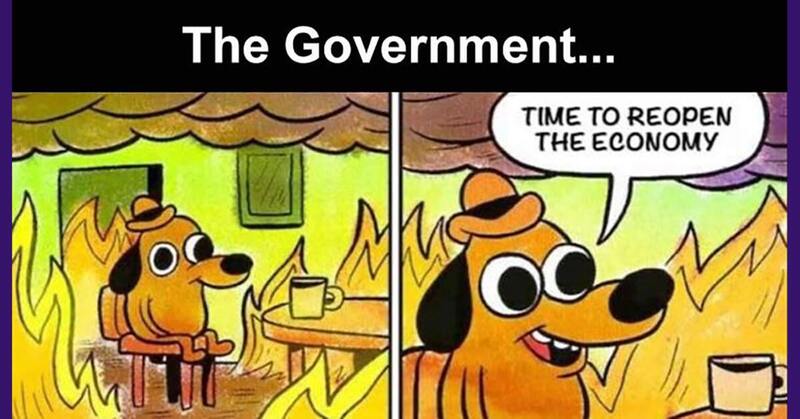 2021-05
2021-05Reopening too Soon
In many states, the government seemingly ended mask mandates and opened back up in one day. Washington State lifted mask mandates and reopened everything at 100% only to reinstate mask mandates and reduce compacity a few weeks later. This has lead to the meme of everything is on fire but let's just reopen anyways. -
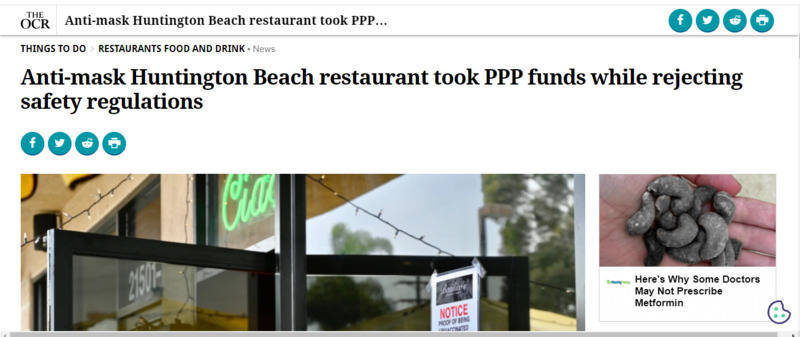 2021-07-29
2021-07-29Basilico’s Pasta e Vino in Huntington Beach
After submitting a restaurant's sign promoting their anti-vax stance I was curious as to whether or not they were still in business. It turns out this restaurant has made quite a buzz in California. They unapologetically promote misinformation and publically prefer their customers to be unvaccinated but happily took thousands in PPP funds. They have spent money on controversial billboards and are not at risk of losing their liquor license. I'm so interested to see where else this story goes. The last sentence of this article sums up the ignorance of the restaurant owner - “Our stand is for all Americans,” wrote Roman. “They can thank us later.” -
 2020
2020Humorous memes about coronavirus
During quarantine I collected many humorous memes about staying at home and the problems that brought. All sorts of subjects were covered: cooking, getting along with your spouse/roommates, homeschooling the kids, learning to bake bread, being stuck at home, sanitizing, facemasks, people hoarding toilet paper, boredom, effects of isolation, etc. Here are a few of those memes. -
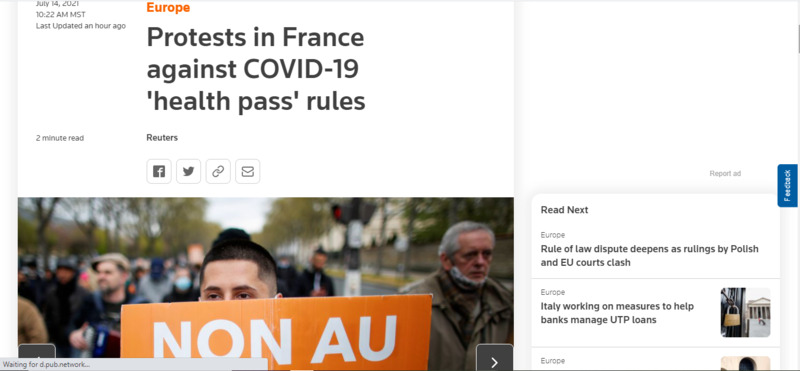 2021-07-14
2021-07-14Protests in France against COVID-19 'health pass' rules
Police in Paris clashed with protesters railing against President Emmanuel Macron's plan to require a COVID-19 vaccine certificate or negative PCR test to gain entry to bars, restaurants and cinemas from next month. Macron this week announced sweeping measures to fight a rapid surge in new coronavirus infections, including the mandatory vaccination of health workers and new health pass rules for the wider public. In doing so, he went further than most other European nations have done as the highly contagious Delta variant fans a new wave of cases, and other governments are watching carefully to see how the French public responds. -
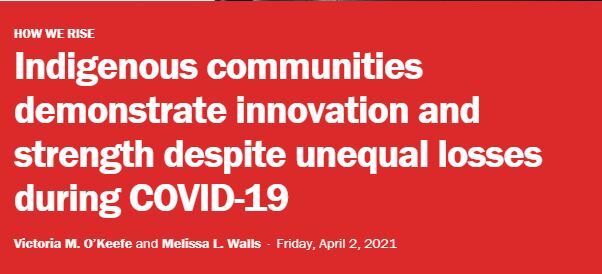 2021-04-02
2021-04-02Strength and Innovation of Indigenous Communities During the Pandemic
This article demonstrates that despite the inequities faced by Native Americans and indigenous populations they have been innovative in combatting the pandemic and shown strength in the face of fear, illness, and uncertainty. -
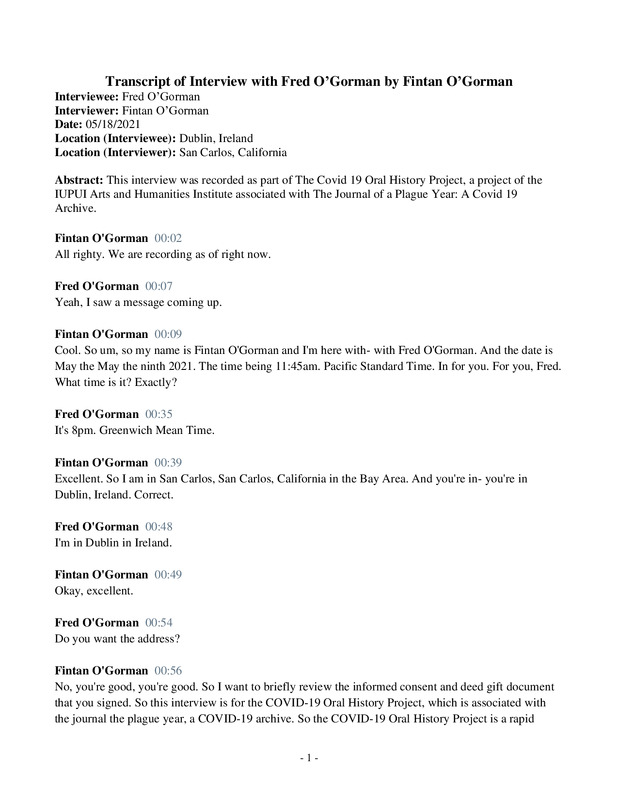 2021-05-09
2021-05-09Fred O'Gorman Oral History, 2021/05/09
Interview conducted by a nephew with uncle regarding the COVID response as it occured in the Republic of Ireland. Interviewee Fred O'Gorman discussed topics ranging from business closure and government response to personal and communal attitudes and behaviors in relation to pandemic in Ireland. The discussion also discussed ongoing vaccine rollout in Ireland and the dynamics of mental health through the course of the pandemic.
